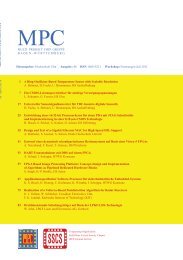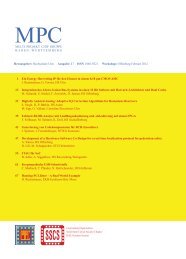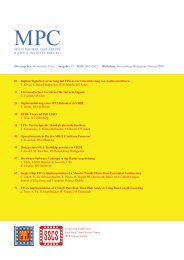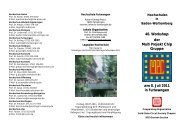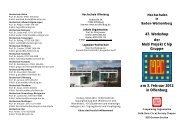Der UMC 0.18 Design Flow am Beispiel eines PDA ... - Mpc.belwue.de
Der UMC 0.18 Design Flow am Beispiel eines PDA ... - Mpc.belwue.de
Der UMC 0.18 Design Flow am Beispiel eines PDA ... - Mpc.belwue.de
Sie wollen auch ein ePaper? Erhöhen Sie die Reichweite Ihrer Titel.
YUMPU macht aus Druck-PDFs automatisch weboptimierte ePaper, die Google liebt.
FPGA Implementation of a HOG-based<br />
Pe<strong>de</strong>strian Recognition System<br />
The next step is called orientation binning and<br />
represents the fund<strong>am</strong>ental nonlinearity of the HOG<br />
<strong>de</strong>scriptor. The <strong>de</strong>tection window is divi<strong>de</strong>d into 8x16<br />
rectangular local spatial regions called cells (Fig. 4).<br />
The 8x8 cell pixels are then discretized into 9 angular<br />
bins according to their gradient orientation. Each pixel<br />
contributes a weighted vote for its corresponding<br />
angular bin, the vote is a function of the gradient<br />
magnitu<strong>de</strong> at the pixel. This way the information is<br />
compressed to a 9-dimensional space per cell. The<br />
angular histogr<strong>am</strong> bins are evenly spaced over 0°-<br />
180°.<br />
3.3. Classification<br />
The generated HOG <strong>de</strong>scriptor is used to categorize<br />
the image patch into one of the pre<strong>de</strong>fined classes,<br />
pe<strong>de</strong>strian or non-pe<strong>de</strong>strian. For this classification<br />
step, Dalal&Triggs employ a support vector machine<br />
(SVM) that learns an implicit representation of the<br />
classification object from ex<strong>am</strong>ples. In case of HOG,<br />
the classifier is pre-trained with the 3780-dimensional<br />
<strong>de</strong>scriptor that is generated for all positive<br />
(pe<strong>de</strong>strian) and negative (non-pe<strong>de</strong>strian) s<strong>am</strong>ples,<br />
available from established datasets.<br />
There are many different classifier concepts in the<br />
domain of supervised learning. Owing to the<br />
popularity in literature - in particular for pe<strong>de</strong>strian<br />
recognition approaches, see [Gandhi 2007], [Mun<strong>de</strong>r<br />
2006] for a comparison - we also <strong>de</strong>ci<strong>de</strong> in favour of<br />
support vector machines.<br />
4. Implementation<br />
Fig. 4: Division of <strong>de</strong>tection window into cells. Histogr<strong>am</strong><br />
generated for a single cell.<br />
4.1. System Overview<br />
The proposed system is based on an FPGA-CPU-<br />
GPU network. We outsourced the corpus of the HOG<br />
<strong>de</strong>scriptor computation to an FPGA. The <strong>de</strong>scriptor<br />
normalization step is then performed on the CPU,<br />
being the central entity of our system. The SVMbased<br />
sliding-window evaluation is currently running<br />
on a publicly available GPGPU solution [cuSVM]. An<br />
overview of the fr<strong>am</strong>ework is shown in fig. 5. This<br />
paper focuses on the FPGA-based HOG <strong>de</strong>scriptor<br />
generation.<br />
Gradient strengths vary over a wi<strong>de</strong> range due to<br />
shadows, local variations in illumination and<br />
foreground-background contrast. Therefore local<br />
contrast normalization is essential for good<br />
performance. For this purpose, groups of 2x2 adjacent<br />
cells are consi<strong>de</strong>red as spatial regions called blocks.<br />
Each block is represented by a concatenation of the<br />
corresponding four cell histogr<strong>am</strong>s, resulting in a 36-D<br />
feature vector that is normalized to unit length, using<br />
the L2 norm.<br />
The final HOG <strong>de</strong>scriptor is represented by a<br />
concatenation of all these normalized block<br />
responses. In fact, blocks typically overlap with each<br />
other in a sliding-window fashion so that each cell<br />
response appears several times in the final feature<br />
vector, each normalized with respect to a different<br />
block. The <strong>de</strong>fault block stri<strong>de</strong> is 8 pixels (1 cell),<br />
resulting in a fourfold coverage of each cell. To<br />
summarize: Each <strong>de</strong>tection window is represented by<br />
7x15 blocks, a block consisting of 2x2 cells, a cell is<br />
represented by a 9-bin histogr<strong>am</strong>, giving a total of<br />
715 ∙ 22 ∙ 9 = 3780 features.<br />
Fig. 5: Overview of the implemented FPGA-CPU-GPU<br />
fr<strong>am</strong>ework.<br />
MPC-Workshop July 2009<br />
52


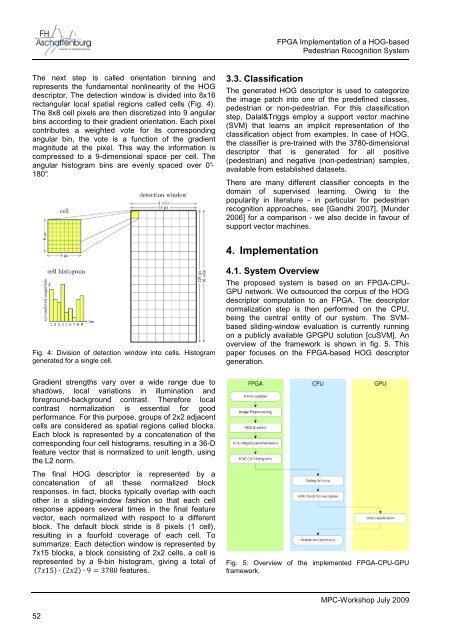
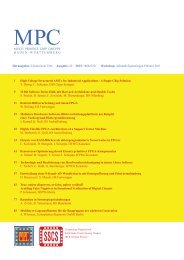
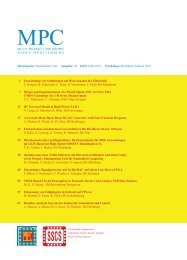
![[Geben Sie hier die Überschrift ein] - MPC](https://img.yumpu.com/8654082/1/188x260/geben-sie-hier-die-uberschrift-ein-mpc.jpg?quality=85)
